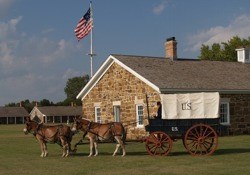Seeking to bring about an end to the state of war instigated by Gen. Hancock’s destruction of the combined village west of Fort Larned, U.S. officials and several tribes including the Cheyenne, Arapaho, Kiowa, Comanche, and Apache agreed to meet at a site southeast of Fort Larned along Medicine Lodge Creek in October 1867. The area was frequently used by the Cheyenne for religious purposes, and the spiritually significant site was selected to emphasize the occasion's importance. As an offering of peace, the U.S. Government provided food for the thousands of people who gathered at the site. Fort Larned served as the supply depot for the Medicine Lodge Treaty proceedings, where food was amassed and driven by wagon to the site. 
NPS The proceedings concluded with the signing of the Medicine Lodge Treaty of 1867. Among its provisions, the Medicine Lodge Treaty relegated the Cheyenne to lands south of Fort Larned. The treaty also allowed the tribes to collect annuities, or gifts, from the government. To the US government, gifts were less expensive than war. Though the treaty could be seen as a diplomatic victory for both sides, Captain Barnitz of the 7th Cavalry, who recorded the speeches during the negotiations, expressed his misgivings. "They have no idea that they are giving up, or that they have ever given up the country which they claim as their own…The treaty amounts to nothing, and we will certainly have another war sooner or later with the Cheyennes, at least, and probably with the other Indians…" Fort Larned was not quite ready to handle its increased diplomatic role. Post Commander Major Meredith W. Kidd wrote to Brig. Gen. McKeever on March 21, 1868, "Now that the Indians are moving about and frequently visiting this post, it seems to me to be necessary or at least prudent, to have an interpreter here for a few months." In August 1868, Captain Barnitz observed the Cheyenne collecting annuities at Fort Larned, noting "The Cheyennes have been coming in to Fort Larned to day for their arms and munitions," which were to be used for hunting bison. However, Army officials were always concerned the weapons would be used against whites. Indeed, peaceful relations did not continue to the end of the year. 
NPS Despite the peaceful start of 1868, violence began increasing again in August. As the peace afforded by the Medicine Lodge Treaty unraveled and the U.S. Army contemplated how to respond, Ned Wynkoop resigned his position as Cheyenne and Arapaho agent. In November, Custer’s 7th Cavalry attacked the Cheyenne village at Washita. In the fight, Captain Barnitz was wounded. Black Kettle, who had worked for years to achieve peace with Wynkoop, was killed in the attack. A sword found near where Black Kettle fell is on display in the Fort Larned visitor center. Fort Larned had been significant at the beginning of Hancock's War and the conflict leading up to the Medicine Lodge Treaty, and the post reached its apogee in the year that followed the Medicine Lodge Treaty. 1868 saw the highest troop levels at Fort Larned, the completion of the last buildings on post, and the busiest year at the fort overall. Afterward, as the conflict moved elsewhere and eventually quieted, the post began a decade-long decline into disuse. |
Last updated: February 2, 2024
